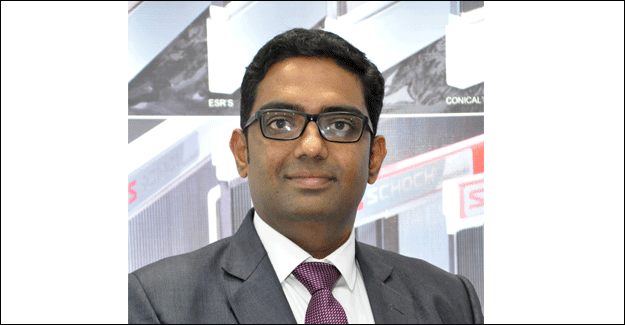
Schoch Reeds' Energy Saving Reeds Are In Much Demand
Energy efficiency has become pivotal in the textile industry in terms of cost management. Bhushan P Dhavate Marketing Manager, Schoch Reeds India Pvt Ltd spoke to Textile Excellence about the company's energy efficient reeds and business issues.
What new did you offer during India ITME 2016?
Our main highlight for ITME 2016 was our Energy Saving Reed (ESR) was launched at ITMA 2015 in Milan, in Italy. After the launch, we have received very good response for ESR which was initially developed for Toyota looms only. Afterwards, looking at the positive response and advantages it offers to customers, our product team got engaged in further R&D to adapt it for other looms made by Picanol and Tsudakoma. Our team carried out extensive trials of ESR at our customers' premises which were very successful, especially in saving power. So at ITME 2016, we have officially launched Energy Saving Reeds for Picanol as well as Tsudakoma looms.
So you have been receiving many inquiries?
Yes, of course. We are targeting customers in the weaving segment who wish to improve their energy savings. We have specifically prepared a report to promote our various technical trials and also their results as well as highlighting the kind of support we give to our customers. Customers have shown keen interest and already some customers have asked us for trials of ESR at their own factories. In fact, four to five customers including Gimatex Industries and RSR Mohta Mills have already given us their nod. We are hopeful of getting more business after these trials.
Why is energy saving so critical for the weaving industry?
There is cut throat competition in the weaving industry. Competition is only going to increase since more weaving capacities are being added to the market. Cost of raw material, power and labour are increasing each year. However, proportionate to that, the price of the final product is not increasing. So, there is a competitive need to cut energy cost by saving energy and thus reduce production cost.
Reduction of energy costs are a critical factor and that is where our product comes in. Our customers wanted us to find a way to reduce the air consumption by using Energy Saving Reeds. It is this requirement on which our research and development team worked successfully.
How much of customer feedback goes into your research and development?
Feedback is very important for us. As per our company's policy, despite knowing that our customers are happy with our products, our technical people seek feedback on our products regularly.
What about energy savings vis-a-vis product efficiency? Will efficiency suffer in the process of saving energy?
When we market our portfolio of energy saving reeds, we always say that due to saving energy, there will be no compromise on product efficiency. Whenever we change the reed from conventional reed to energy saving reeds, our technical team removes the first 120 metres of roll from the machine and carry out an inspection to ensure that fabric quality is not affected. It is only after efficiency and fabric quality has been achieved at our customers' end, we do take steps to save compressed air. We are not interested in compromising on machine efficiency and fabric quality by means of energy saving.
What are the particular challenges in this segment?
The challenge is that there are varying qualities of fabric being run on machines. So, with differing fabric quality and different kinds of machines, the amount of compressed air saving achieved is different. Sometimes, we get less air saving and sometimes we achieve a higher saving. In areas like denim, we get the maximum positive results. However, in other areas like polyester weaving or lycra weaving, we get lesser positive results. So, there are challenges of not managing to save air to the extent that our customers expect. We intend to improve in this area and achieve positive results of around 15 per cent to 20 per cent compressed air saving.
How many customers do you have in India and how many do you have overseas?
It is difficult to put the numbers but I can safely say that at the moment, we have more than 500 customers in India. We also export to Bangladesh, Vietnam, Mauritius and Madagascar.
Within India, which are the geographical areas from where your business comes?
We expect demand to come from all corners of India. However, specifically for our energy saving reeds, the demand is more from South India, where power cost is very high. In South India, a saving of 15% is considered quite huge. We also see demand for this product coming from other regions. For over all business, we see lot of growth potential for us in the next five years. We see sales volumes increasing year on year. At present, we have around 25% market share and we hope to increase it further.
Textile Excellence
If you wish to Subscribe to Textile Excellence Print Edition, kindly fill in the below form and we shall get back to you with details.








